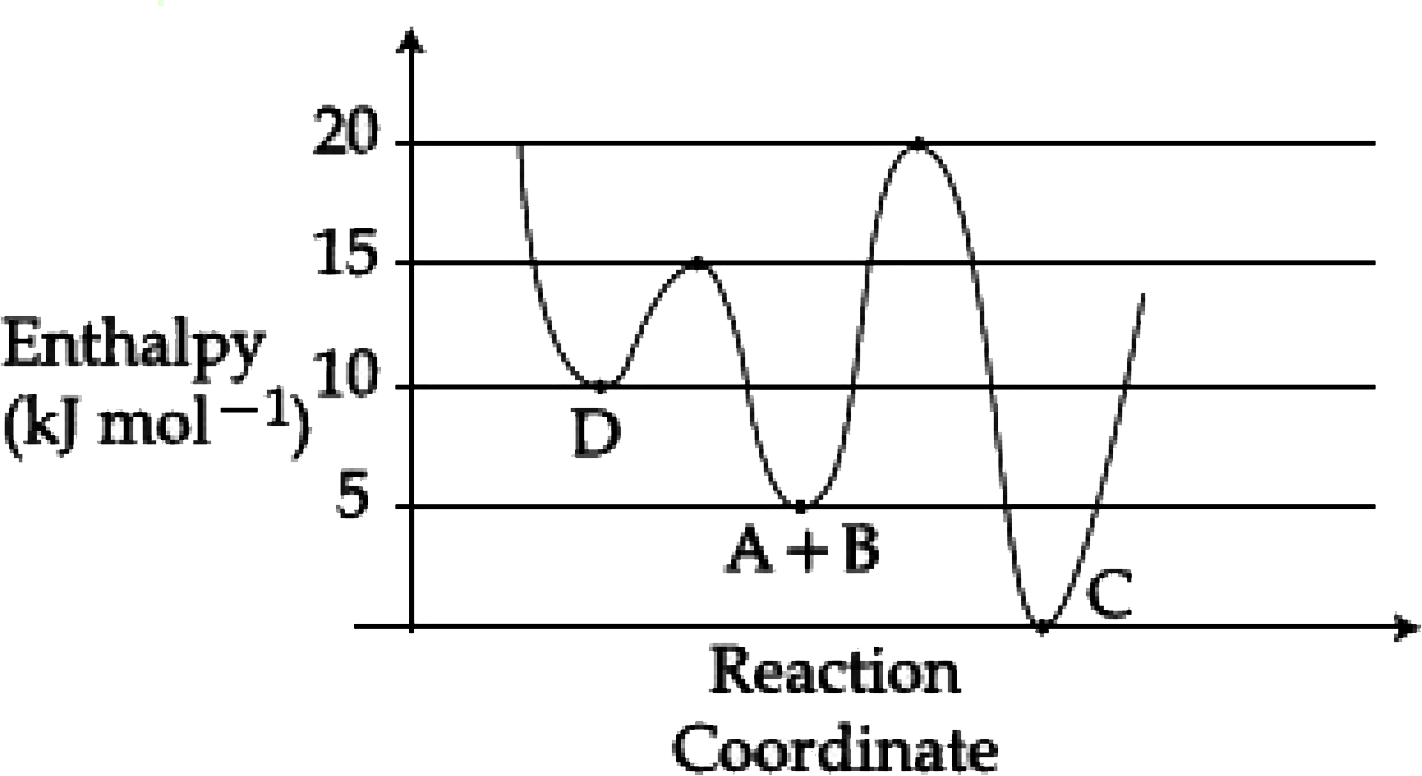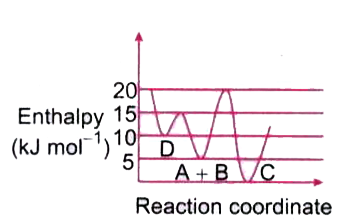A reaction takes place in a several sequential steps A,B,C and D. the vlaue of enthalpy change for sequential steps are p,q,r and s respectively. If A and C have equal values of enthalpy change with total enthalpy change is t, then choose the incorrect statement among the following.
A
q=r
B
q+r=t−(s+p)
C
2q=t−(s+p)
D
q+r=p+s
Text Solution
The correct Answer is:D
According to the question, the diagramatic representation of given reaction can be drawn as

As given, q=r [Hence, (a) is correct]
Using concept of Hess's law
t=p+q+r+s
∴q+r=t−(s+p) [hence (b) is correct]
2q=t−(s+p) [hence (c) is correct]
[∵q=r]
but q+r=p+s is incorrect because exact amount of enthalpy change for each step is not given.
|
Topper's Solved these Questions
- CHEMICAL THERMODYNAMICS AND ENERGETICBOOK - MHTCET PREVIOUS YEAR PAPERS AND PRACTICE PAPERSCHAPTER - CHEMICAL THERMODYNAMICS AND ENERGETICEXERCISE - MHT CET Corner
40 Videos
- CHEMICAL THERMODYNAMICS AND ENERGETICBOOK - MHTCET PREVIOUS YEAR PAPERS AND PRACTICE PAPERSCHAPTER - CHEMICAL THERMODYNAMICS AND ENERGETICEXERCISE - Exercise 1
88 Videos
- CHEMICAL KINETICS BOOK - MHTCET PREVIOUS YEAR PAPERS AND PRACTICE PAPERSCHAPTER - CHEMICAL KINETICS EXERCISE - MHT CET CORNER
20 Videos
- CHEMISTRY IN EVERYDAY LIFE BOOK - MHTCET PREVIOUS YEAR PAPERS AND PRACTICE PAPERSCHAPTER - CHEMISTRY IN EVERYDAY LIFE EXERCISE - MHT CET CORNER
11 Videos
Similar Questions
Knowledge Check
Consider the given plot of enthalpy of the following reaction between A and B. A+B→C+D. Identify the incorrect statements
 AActivation enthalpy to from C is 5 kj mol−1 less than that to form D.BC is the thermodynamics stable product.CD is kinetically stable product.DFormation A and B from C has highest enthalpy of activation.
AActivation enthalpy to from C is 5 kj mol−1 less than that to form D.BC is the thermodynamics stable product.CD is kinetically stable product.DFormation A and B from C has highest enthalpy of activation.Consider the given plot of enthalpy of the following reaction between A and B. A+B→C+D. Identify the incorrect statement.
 AC is the thermodynamically stable product.BFormation of A and B from C has highest enthalpy of activation.CActivation enthalpy to form C is 5 kJ mor less than that to form D.DD is kinetically stable product.
AC is the thermodynamically stable product.BFormation of A and B from C has highest enthalpy of activation.CActivation enthalpy to form C is 5 kJ mor less than that to form D.DD is kinetically stable product.In a reaction P+Q→R+S, there is no change in entropy, Enthalpy change for the reaction (ΔH) is 12 kJ mol−1. Under what conditions, reaction will have negative value of free energy change?
AIf ΔH is positiveBIf ΔH is negative.CIf ΔH is 24 kJ mol−1.DIf temperature of reaction is high
A reaction A+B→C+D+q is found to have a positive entropy change, the reaction will be:
View SolutionA reaction A+B→C+D+q is found to have a positive entropy change, the reaction will be:
View SolutionGiven the following diagram for the reaction A+B→C+D The enthalpy change and activation energy for the reverse reaction, C+D→A+B are respectively.

View SolutionGiven the following diagram for the reaction A+B→C+D The enthalpy change and activation energy for the reverse reaction, C+D→A+B are respectively.

View SolutionIn a reaction P+Q→R+S, there is no change in entropy, Enthalpy change for the reaction (ΔH) is 12 kJ mol−1. Under what conditions, reaction will have negative value of free energy change?
View Solution
